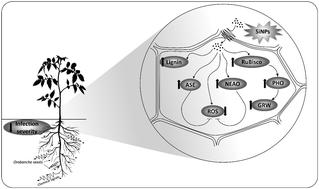当前位置:
X-MOL 学术
›
Environ. Sci.: Nano
›
论文详情
Our official English website, www.x-mol.net, welcomes your feedback! (Note: you will need to create a separate account there.)
Silicon dioxide nanoparticles alleviate the threats of broomrape infection in tomato by inducing cell wall fortification and modulating ROS homeostasis
Environmental Science: Nano ( IF 7.3 ) Pub Date : 2020-03-13 , DOI: 10.1039/c9en01255a Mahmoud M. Y. Madany 1, 2, 3, 4, 5 , Ahmed M. Saleh 1, 2, 3, 4, 5 , Talaat H. Habeeb 6, 7, 8, 9, 10 , Wael N. Hozzein 7, 11, 12, 13, 14 , Hamada AbdElgawad 2, 5, 15, 16, 17
Environmental Science: Nano ( IF 7.3 ) Pub Date : 2020-03-13 , DOI: 10.1039/c9en01255a Mahmoud M. Y. Madany 1, 2, 3, 4, 5 , Ahmed M. Saleh 1, 2, 3, 4, 5 , Talaat H. Habeeb 6, 7, 8, 9, 10 , Wael N. Hozzein 7, 11, 12, 13, 14 , Hamada AbdElgawad 2, 5, 15, 16, 17
Affiliation

|
Infestation by parasitic weeds is one of the most important environmental challenges threatening cropping systems worldwide. Among these, branched broomrape (Orobanche ramosa), a root holoparasitic weed, detrimentally affects many crops especially tomato (Lycopersicon esculentum) and causes severe crop losses. The positive role of silicon nanoparticles (SiNPs) in the growth and yield of plants grown under stressful conditions has been reported. However, no study has investigated the impact of SiNPs on plant–weed interaction. In this study, we conducted a green-house experiment to assess the physiological implications of SiNPs on tomato under the Orobanche challenge. Orobanche infection alone markedly inhibited tomato growth and photosynthesis (P < 0.0001) and induced oxidative damage via increased photorespiration (P < 0.0001) and NADPH oxidase activities (P < 0.01). Interestingly, SiNPs significantly reduced the infection severity by reducing both the number and biomass of Orobanche tubercles (13 and 31% decrease, respectively). Moreover, SiNPs dramatically ameliorated the physiological and biochemical disorders imposed by Orobanche in tomato. Consistently, SiNPs strengthened the cell wall of host roots by upregulating lignin biosynthesis that acts as a physical barrier against tubercle haustorial penetration. On the other hand, SiNPs caused a noticeable decrease in ROS production and improved both enzymatic and non-enzymatic detoxification systems, the thing that was more pronounced in roots than in shoots of infected tomato plants. Such organ-specific responses were confirmed by cluster analysis. Overall, this study suggests that tomato plants treated with SiNPs will be more tolerant to Orobanche infection through enhanced structural and metabolic responses.
中文翻译:

二氧化硅纳米颗粒通过诱导细胞壁强化和调节ROS稳态来减轻番茄中帚柄感染的威胁
寄生性杂草的侵染是威胁全球种植系统的最重要的环境挑战之一。其中,分支,帚(Orobanche ramosa)是全寄生的根杂草,对许多作物特别是番茄(番茄(Lycopersicon esculentum))有害,并造成严重的作物损失。已经报道了硅纳米颗粒(SiNPs)在压力条件下生长的植物的生长和产量中的积极作用。但是,尚无研究调查SiNP对植物与杂草相互作用的影响。在这项研究中,我们进行了温室实验,以评估在Orobanche挑战下SiNPs对番茄的生理影响。Orobanche单独的感染显着抑制番茄的生长和光合作用(P <0.0001),并通过增加光呼吸(P <0.0001)和NADPH氧化酶活性(P <0.01)引起氧化损伤。有趣的是,SiNPs通过减少Orobanche结节的数量和生物量来显着降低感染的严重程度(分别降低了13%和31%)。而且,SiNPs大大改善了Orobanche造成的生理和生化疾病在番茄中。始终如一,SiNPs通过上调木质素的生物合成来增强宿主根的细胞壁,木质素的生物合成是阻止结节性结膜穿透的物理屏障。另一方面,SiNPs导致ROS产量显着下降,并改善了酶促和非酶促解毒系统,这种现象在根部比在受感染的番茄植株的芽中更为明显。通过聚类分析证实了这种器官特异性反应。总体而言,这项研究表明,用SiNPs处理的番茄植株通过增强的结构和代谢反应,将更耐Orobanche感染。
更新日期:2020-03-13
中文翻译:

二氧化硅纳米颗粒通过诱导细胞壁强化和调节ROS稳态来减轻番茄中帚柄感染的威胁
寄生性杂草的侵染是威胁全球种植系统的最重要的环境挑战之一。其中,分支,帚(Orobanche ramosa)是全寄生的根杂草,对许多作物特别是番茄(番茄(Lycopersicon esculentum))有害,并造成严重的作物损失。已经报道了硅纳米颗粒(SiNPs)在压力条件下生长的植物的生长和产量中的积极作用。但是,尚无研究调查SiNP对植物与杂草相互作用的影响。在这项研究中,我们进行了温室实验,以评估在Orobanche挑战下SiNPs对番茄的生理影响。Orobanche单独的感染显着抑制番茄的生长和光合作用(P <0.0001),并通过增加光呼吸(P <0.0001)和NADPH氧化酶活性(P <0.01)引起氧化损伤。有趣的是,SiNPs通过减少Orobanche结节的数量和生物量来显着降低感染的严重程度(分别降低了13%和31%)。而且,SiNPs大大改善了Orobanche造成的生理和生化疾病在番茄中。始终如一,SiNPs通过上调木质素的生物合成来增强宿主根的细胞壁,木质素的生物合成是阻止结节性结膜穿透的物理屏障。另一方面,SiNPs导致ROS产量显着下降,并改善了酶促和非酶促解毒系统,这种现象在根部比在受感染的番茄植株的芽中更为明显。通过聚类分析证实了这种器官特异性反应。总体而言,这项研究表明,用SiNPs处理的番茄植株通过增强的结构和代谢反应,将更耐Orobanche感染。



























 京公网安备 11010802027423号
京公网安备 11010802027423号